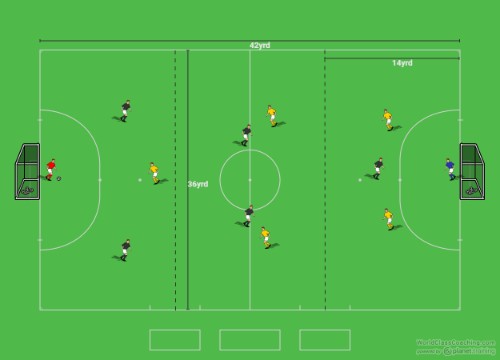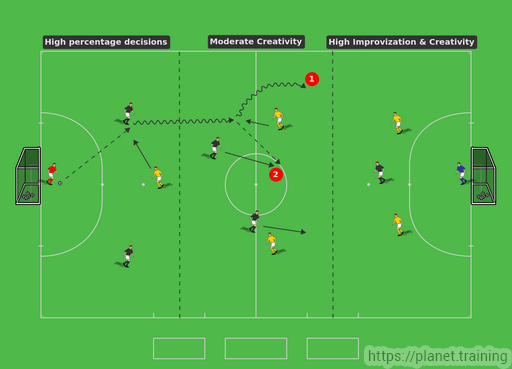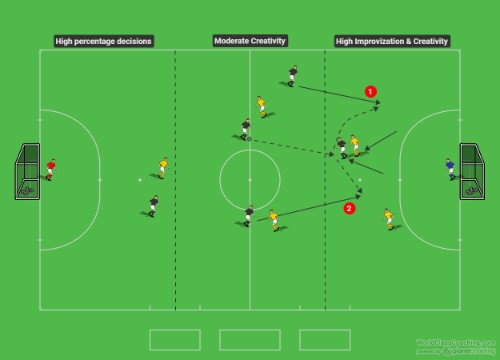By Sean Pearson
Area Size: 36 x 42 Yards
Teams: 15 mins
Players: 6 v 6
Objectives
- To understand when and where to improvise and be creative
- For players to feel encouraged to try different ways of attacking to increase confidence
Set-Up
Three zones of equal area divide the field into 3 sections. There is an overload of 3v1 in the defensive zones to start with and 2v2 in the midfield section.
 Execution
Execution
Each section has degree of creativity set upon it. At the back when building possession you want your team to make high percentage decisions. Whether it be passes or bringing the ball forward but with 3v1 you do not want to take any chances. Move the ball until one of the center backs can pass or bring the ball forward out of the area into the midfield area. The other 2 players can’t follow this player into the midfield area.
Now you create a 3v2 but what you try and create is a 2v1. The spare midfielder looks to take one defender away with their movement. 1) The CB then can look to take on the midfielder with speed, especially if the midfielder positions themselves on the inside to allow more space on the outside (note the original position of the other midfielder sitting just behind the CB in case possession is lost). 2) the CB can play a pass into the space with the outside of their foot after drawing the midfielder in close to them.

As the ball is brought further forward there should be more encouragement on being creative and improvising but also making fast decisions when doing so. Forward runs will help with getting more players forward and making the defenders unsure of where the ball will go. Below the striker starts deep and makes a run towards the ball, bringing a defender with them. At the same time the two wider players in the middle zone make forward runs. Now the defenders are outnumbered 3v2 and can’t mark everybody. It is important that the striker doesn’t broadcast their intentions by changing their body shape to show their planned passing option.
- Hold off the defender and use the pace of the pass and the outside of their right foot to help the ball forward but also spin the ball into the path of the player. Your player could also receive the ball facing the opposite way then backheel the ball into the player's path.
- Your player could do the same type of pass with the left foot for the opposite side or shape to face the left sided player only to play a pass behind them through their legs to the right sided player.

Further options going forward can be:
- Passes through the midfield with a little disguise on them maybe using outside of the foot. Then the receiving player can take on any defender who engages.
- Switch the ball across to the spare player who drives forward into the attacking area. As they are close to the goal encourage them to dribble past any defender they encounter.
- If they do decide to pass can the striker be aware of players around them who may be in a better opportunity to shoot/score from. As they come across they bring a defender with them and therefore away from the player on the other side. The allow the ball to go through their legs, committing the defender because if they are not close the striker would have the space to shoot.

When in the attacking area and the play breaks down continually encourage improvisation from players, whether it be backheels, no look passes, flicks etc. Because the one thing defenders don’t like is when a team is unpredictable.
Variations
- Only allow a goal if a defender has been dribbled past
- Set targets of each team must try 1/2/3 dummies/backheels/flicks in a certain time limit
By Sean Pearson. Sean is also the author Coaching Team Shape in the 3-3-1, Coaching Team Shape in the 4-2-3-1 and Coaching Team Shape in the 4-3-3


